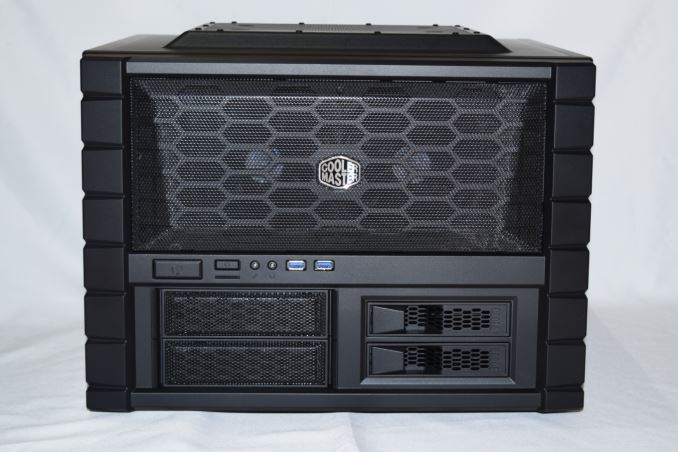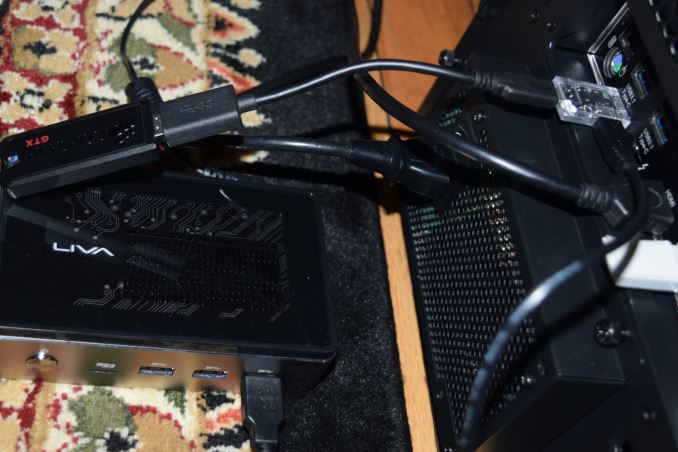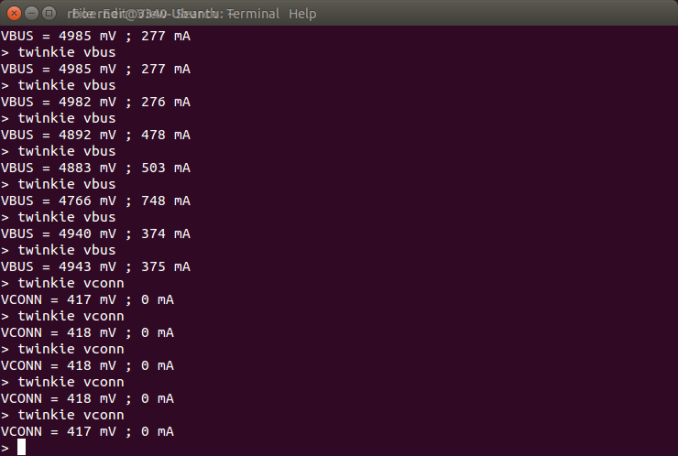USB Flash Drives - Power Consumption Measurement using Plugable's USBC-TKEY
by Ganesh T S on March 18, 2016 9:10 AM EST- Posted in
- Gadgets
- Flash Drive
- DAS
- USB-C
- Plugable
Hardware Setup and Software Aspects
Plugable's USBC-TKEY comes in a simple package with multiple cables, but, for our purpose, we only need the main unit and the USB 2.0 Micro-B to Type-A cable. The gallery below shows the package contents and a few close-up shots of the main unit. Note that the main unit comes with a Type-C male connector to link up to the host port and a Type-C female connector to attach the device to. In addition, there is a micro-USB 2.0 connector on the side which enables the USBC-TKEY to communicate the sniffed data to another system for further analysis.
The host device used as the 'test system' was our Skylake DAS Testbed (specifications outlined below).
| AnandTech DAS Testbed Configuration | |
| Motherboard | GIGABYTE Z170X-UD5 TH ATX |
| CPU | Intel Core i5-6600K |
| Memory | G.Skill Ripjaws 4 F4-2133C15-8GRR 32 GB ( 4x 8GB) DDR4-2133 @ 15-15-15-35 |
| OS Drive | Samsung SM951 MZVPV256 NVMe 256 GB |
| SATA Devices | Corsair Neutron XT SSD 480 GB Intel SSD 730 Series 480 GB |
| Add-on Card | None |
| Chassis | Cooler Master HAF XB EVO |
| PSU | Cooler Master V750 750 W |
| OS | Windows 10 Pro x64 |
| Thanks to Cooler Master, GIGABYTE, G.Skill and Intel for the build components | |
The USBC-TKEY was plugged into one of the Thunderbolt 3 / USB 3.1 Gen 2 Type-C ports enabled by the Alpine Ridge controller. While the USBC-TKEY acts as a transparent interposer for the host's port, it needs to be connected to a Ubuntu system for data gathering purposes via its micro-USB port. We chose the ECS LIVA Core (one of the low power PCs at our disposal) and installed Kubuntu 15.10 on it. Plugable's documentation indicates proper support for Ubuntu 14.04 only and advises the use of a USB 2.0 port on the data gathering machine. However, we had no trouble connecting the kit to a USB 3.0 port on a ECS LIVA Core running Kubuntu 15.10.
Plugable's documentation for the USBC-TKEY mostly deals with the capture and viewing of the power delivery packets being exchanged over the interposer [ Update: New documentation for the advanced features of the USBC-TKEY is now available on Plugable's website. It also provides a step-by-step guide to enable the serial console - a process described below in brief ]. However, our requirements were a bit different. Google's Twinkie documentation came to our rescue. Once the interposer link became active (i.e, device was connected to the USBC-TKEY so that it could communicate with the host), the USBC-TKEY itself became visible on the Kubuntu machine. Executing a 'modprobe usbserial' enabled a serial console for the device. There are multiple ways to access this serial console (/dev/ttyUSB0 in our case), but, for a quick check to make sure everything was up and running normally, we used 'screen'. Out of the various commands available, the 'twinkie vbus' provided us the required information.
A little bit of Python scripting using the 'serial' module enabled the creation of a CSV file with the vbus parameters (and, hence, the power consumed by the USB peripheral) sampled at pre-configured time intervals. The CSV file could then be fed to external tools / scripts to generate a graph of the power delivered through the interposer as a function of time.



















20 Comments
View All Comments
InterClaw - Friday, March 18, 2016 - link
How about a graph comparing total power consumption for a specific task, like "rush to idle".icrf - Friday, March 18, 2016 - link
What is the closest model for a streaming use case? Sequential QD=1 sounds close, but if streaming videos stored on a USB drive on a tablet/phone, you're not running at peak throughput even at QD=1. That's also the kind of case where power consumption and battery life matter a lot.I don't know if that's the kind of task you were referring to with "rush to idle".
InterClaw - Friday, March 18, 2016 - link
I mean like performance per watt, so even if a drive consumes more power doing a certain task it maybe finishes a lot quicker and the total amount of power consumed could actually be less. Perhaps figures like this could be interesting to include in the future.ISGoodwin - Friday, March 18, 2016 - link
While maximum power draw for certain tasks, it would be helpful to be able to see a normalized figure to be able to compare efficiency. It may even be necessary to have a test that has a specific set of usual tasks, heavy, medium and light like you do with the SSD reviews to see how the characteristics change depending on load.jabber - Friday, March 18, 2016 - link
Have to say power consumption is the last concern I have re. USB sticks. Some folks have far too much time on their hands.name99 - Friday, March 18, 2016 - link
You (and plenty of the commenters above) are being exceptionally ignorant, and didn't read the article properly where this is all explained.There is a HARD CAP on the power draw available to a USB2 port of 2.5 W. There is a HARD CAP available to a USB3 port of 4.5W.
This means that if you take one of the drives in the list that exceeds 2.5W under some conditions. it will (more or less randomly) work then fail when connected to a standard USB2 port --- essentially it will exhibit random (and thus very hard to debug) failure, especially since it will always mount without a problem. Even if you're connecting it to USB, if you're connecting to a hub you may have the exact same problem --- the drive always appears to mount, then sporadically fails when a sequence of random reads or writes exceeds the current available (given that some other device on the hub is also using power).
THAT is why the important number for these devices is the worst-case peak number, not an average or the total power consumption or anything like that.
ISGoodwin - Friday, March 18, 2016 - link
While you have a valid point about non type C connectors, it was not the only one in the article as the implication I read was how the power of a storage stick can adversely affect the life of a portable device which would make efficiency a major factor. No-one has mentioned removing the above information, only adding to it, which can only help.InterClaw - Friday, March 18, 2016 - link
Ideally, the drive should enter a low performance mode under those circumstances so as to not encounter failures. But perhaps that's wishful thinking.krutou - Saturday, March 19, 2016 - link
Based on name99 and dano_spumoni's comments, this article should have been named and focued on "Peak Power Consumption Measurement..."I've had similar connection issues when running a portable SSD via front panel USB.
Murloc - Sunday, March 20, 2016 - link
just because you're not connecting external HDs to your phone